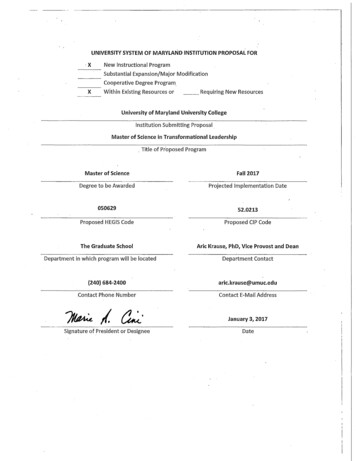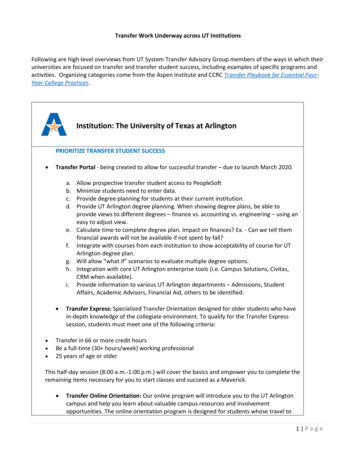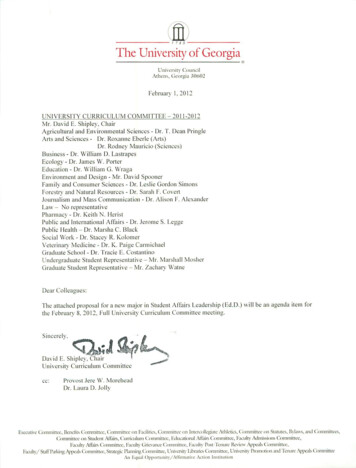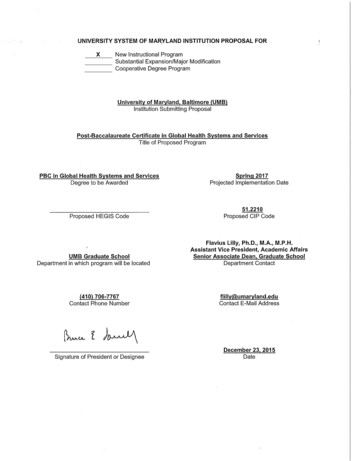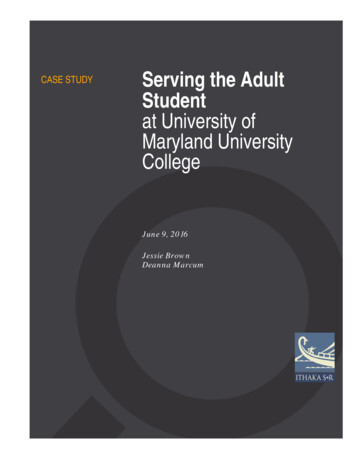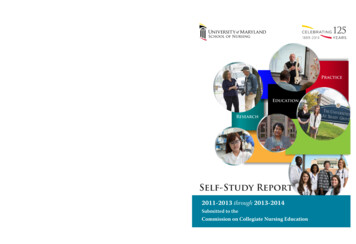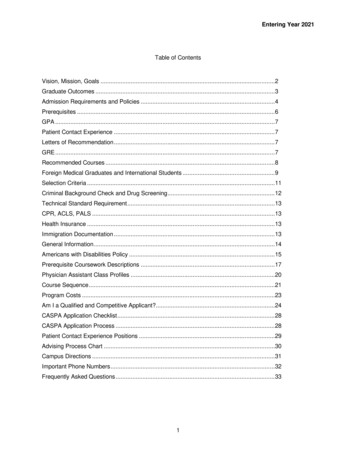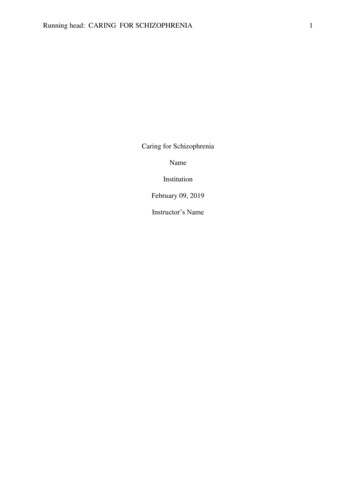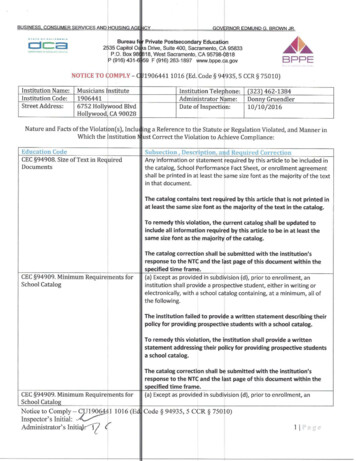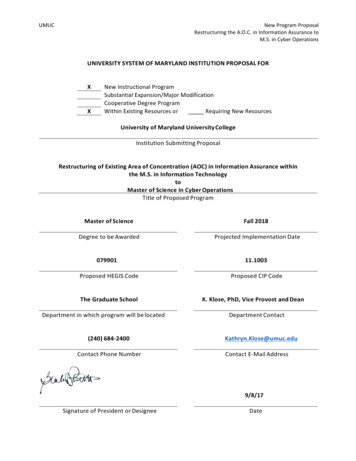
Transcription
UMUCNew Program ProposalRestructuring the A.O.C. in Information Assurance toM.S. in Cyber OperationsUNIVERSITY SYSTEM OF MARYLAND INSTITUTION PROPOSAL FORXXNew Instructional ProgramSubstantial Expansion/Major ModificationCooperative Degree ProgramWithin Existing Resources orRequiring New ResourcesUniversity of Maryland University CollegeInstitution Submitting ProposalRestructuring of Existing Area of Concentration (AOC) in Information Assurance withinthe M.S. in Information TechnologytoMaster of Science in Cyber OperationsTitle of Proposed ProgramMaster of ScienceFall 2018Degree to be AwardedProjected Implementation Date079901Proposed HEGIS CodeThe Graduate SchoolDepartment in which program will be located(240) 684-2400Contact Phone Number11.1003Proposed CIP CodeK. Klose, PhD, Vice Provost and DeanDepartment ContactKathryn.Klose@umuc.eduContact E-Mail Address9/8/17Signature of President or DesigneeDate
UMUCNew Program ProposalRestructuring the A.O.C. in Information Assurance toM.S. in Cyber OperationsUniversity of Maryland University CollegeMaster of Science in Cyber OperationsUniversity of Maryland University College (UMUC) proposes to restructure and revise theexisting Area of Concentration (A.O.C.) in Information Assurance (HEGIS 070200; CIP 11.0401)within the Master of Science (M.S.) in Information Technology. The change consists of removingand discontinuing the Information Assurance curriculum from the M.S. in InformationTechnology and restructuring the curriculum as a freestanding M.S. in Cyber Operations(proposed new HEGIS 079901; proposed new CIP 11.1003). The restructured M.S. programrequires the successful completion of six six-credit courses for a total of 36 semester hours ofgraduate-level coursework.A. Centrality to Institutional Mission Statement and Planning Priorities1. Program description and alignment with missionConsistent with the institutional purpose as stipulated by State statute (Md. EducationCode Ann. § 13-101(2012)), the mission of UMUC is improving the lives of adultlearners. UMUC will accomplish this by:(1) Operating as Maryland’s open university, serving working adults, militaryservicemen and servicewomen and their families, and veterans who reside inMaryland, across the United States, and around the world;(2) Providing our students with affordable, open access to valued, quality highereducation; and(3) Serving as a recognized leader in career-relevant education, embracinginnovation and change aligned with our purpose and sharing our perspectivesand expertise.The purpose of restructuring the curriculum to create a freestanding M.S. in CyberOperations is to 1) strengthen the curriculum and better align it with the needs ofemployers via competency- based teaching and learning approaches and 2) clarify thecontent of the degree and simplify the pathway to completion so that it can be morereadily communicated to prospective and current students and employers.The current structure of having the A.O.C. in Information Assurance nested within theM.S. in Information Technology places an emphasis on the core coursework in generalInformation Technology rather than on the specific content of the concentration inInformation Assurance. The revised program structure benefits students and employersby more clearly focusing the content on Information Assurance and Cyber Operations. Asa result, UMUC will be better able to differentiate the degree from others within itsportfolio of offerings and ensure the currency and relevancy of the curriculum relative tocurrent workforce and employer demands.The proposed M.S. in Cyber Operations program is aimed at those with academic and/orprofessional backgrounds in hands-on computer sciences. The targeted audience includes
UMUCNew Program ProposalRestructuring the A.O.C. in Information Assurance toM.S. in Cyber Operationsearly or mid-career individuals with experience in the military, public, or private sectorswho desire to expand their knowledge and skill set in cybersecurity technologies in orderto enhance their opportunities for special operations in cyber space. The revised M.S. inCyber Operations is a highly technical program grounded in computer sciences. The M.S.program is being designed to meet the requirements of NSA Centers of Excellence inCyber Operations,1 and is in support of the President's National Initiative forCybersecurity Education (NICE). The emphasis of the program is on technologies andtechniques related to operations in cyber space to enhance the security of our nation.The new program builds on the existing A.O.C. by recombining content of the existing threecredit courses to create a new series of six-credit courses, refining and adding contentconsistent with current industry practices and requisite knowledge and skills, and incorporatingnew delivery and assessment methods based on the principles of project- and competencybased pedagogy. The 6-credit hour structure reflects the increased workload required percourse. The new series of six six-credit course will present a streamlined path to degreecompletion.2. Alignment with institutional strategic goalsAs the public state and national leader in distance and distributed education, UMUCawards associate’s, bachelor’s, master's and doctoral degrees, as well as undergraduateand post-baccalaureate certificates. The university’s academic inventory offers programsthat are core to any public university, but UMUC’s mission to the adult student results inan emphasis on workforce-relevant programs. Consequently, the university awardsdegrees and certificates in the arts and humanities, behavioral and social sciences,business and management, health-related fields, computing, education and technology,including degrees in fields facing critical shortages, such as cybersecurity, informationsecurity, and graduate-level teacher-training in STEM areas. As part of its emphasis onworkforce needs, UMUC offers non-credit professional development programs such asthose in executive leadership and hosts professional conferences and meetings thatsupport the economic and societal needs of the State.This proposal aligns with UMUC’s mission by providing a learner-focused program basedon leading-edge adult learning theory and curriculum design that addresses the needs ofstudents and the community. The revised program is consistent with UMUC’scommitment to offering current and relevant degrees that prepare students for theworkforce. Students are given time to practice skills as they progress through formativeinstruction and engage in authentic assessment of learning. The program will supportstudents’ professional development with project-based opportunities to learn fromemployers and peers. The program model offers flexibility and continuing educationopportunities to adults interested in refreshing and reshaping their career opportunities.1NSA Centers of Excellence in Cyber Operations rs/centers-academic-excellence/cyber-operations/
UMUCNew Program ProposalRestructuring the A.O.C. in Information Assurance toM.S. in Cyber OperationsB. Adequacy of Curriculum Design and Delivery to Related Learning Outcomes1. Program requirementsThe M.S. in Cyber Operations is an interdisciplinary technical program that provides asolid foundation in competencies and skills related to security principles andarchitecture, networks security, risk analysis, applied cryptography, and informationassurance, cyber law, forensics, software reverse engineering and cyber offense. Theprogram requires students to demonstrate competencies in hands-on computersciences, specifically in the following areas: (1) C, assembler and system programming,(2) operating systems, (3) computer architecture, (4) mobile and cellularcommunications and networking, (5) virtualization & cloud computing, and (6) discretemathematics.This program revision restructures and enhances the existing curriculum by incorporatingteaching, learning, and assessment strategies that focus on students developingconcrete, job-related knowledge and skills. The revised curriculum is based on principlesof competency- and performance-based learning. The required competencies comprisingthe program learning outcomes have been developed and verified with the help ofacademic experts and employers and drive the program curriculum and assessments. Theapproach is learner-focused, and authentic assessments are embedded in every step ofthe learning process. Through embedded assessments, students perform real-worldauthentic project-based tasks, demonstrating their knowledge and skills as they worktoward mastery. Students “learn by doing” and graduate better prepared for workplaceopportunities.As shown below, the revised M.S. in Cyber Operations (COP) requires the completion of six6-credit courses for a total of 36 credits. Core to the revised program is a 6-creditfoundational course that is required for all graduate students and that covers essentialintra- and interpersonal competencies required for successful graduate work andidentified by employers as highly desirable in graduates. This course includes the corecompetencies of written and oral communications, critical thinking, quantitativereasoning and leadership. The remaining five 6-credit courses build on the foundation tocomplete the degree, keeping the total number of credits the same as in the originalA.O.C. offering. This revised program represents UMUC’s commitment to offering currentand relevant degrees to its students. Course descriptions are presented in Appendix A.Required Courses for the M.S. in Cyber Operations: CBR 600 Communicating, Problem Solving, and Leading in Cybersecurity (6)COP 610 Foundations of Cyber Operations (6)COP 620 Cybersecurity Defense (6)COP 630 Cyber Law & Digital Forensics (6)
UMUCNew Program ProposalRestructuring the A.O.C. in Information Assurance toM.S. in Cyber Operations COP 640 Secure Software (6)COP 670 Cyber Offense & Capstone (6)2. Educational objectives and student learning outcomesThrough completion of the foundational course (CBR 600), students who complete theM.S. in Cyber Operations will be able to: Communicate clearly both orally and in writing. Apply logical processes to formulate clear, defensible ideas and to draw conclusionsbased on the consideration of ethical implications. Use mathematical information, operations and quantitative analyses to solveproblems and inform decision-making. Lead, facilitate, and collaborate with a variety of individuals and diverse teams toachieve organizational objectives.Through completion of the sequential COP courses, students who complete the M.S. inCyber Operations will be able to: Apply the security foundational knowledge and skills including security firstprinciples, access control and layered defense in protecting information assets. Perform risk analysis of information systems. Leverage cryptographic techniques for protecting information systems. Employ tools and techniques for protecting enterprise assets including networks,hosts and devices from cyber threats. Carry out network, media and RAM forensics tasks for common operatingsystems and devices. Utilize static and dynamic analysis tools to find security vulnerabilities insoftware. Use tools and techniques for secure design and coding of software. Apply reverse engineering techniques for malware analysis and generation. Formulate a cyber-offense campaign in compliance with applicable U.S. laws. Carry out steps in a cyber-offense exercise including exploit development, andnetwork and web hacking.3. General education requirementsNot applicable.4. Specialized accreditation or graduate certification requirementsNot applicable.5. Contractual agreement with other institutionsNot applicable.
UMUCNew Program ProposalRestructuring the A.O.C. in Information Assurance toM.S. in Cyber OperationsC. Critical and Compelling Regional or Statewide Need as Identified in the State Plan1. Demand and need for the programWe used data and models of Economic Modeling Specialists International (EMSI)2 to provideevidence of program demand.A key word search on skills or topics that these programs emphasize (e.g., software security,software vulnerability, vulnerability exploitation, penetration testing, ethical hacking) identified133,367 and 109,13 unique job postings in the nation and Maryland, respectively, from Feb.2016 to Feb. 2017. Maryland ranks third nationally in the number of jobs advertised in thesesearches, next only to Virginia and California, as shown below in Figure 1 (the darker the color,the more the demand there is):Figure 1. Demand for Skills Emphasized by the Cyber Operations ProgramStateUnique Postings (Feb 2016 - Feb exas10,444New York5,560The five occupations that are most relevant to the topics and skills emphasized in the program2Economic Modeling Specialists International (EMSI): http://www.economicmodeling.com/
UMUCNew Program ProposalRestructuring the A.O.C. in Information Assurance toM.S. in Cyber Operationsare:1.2.3.4.5.Information Security AnalystsComputer and Information Systems ManagersSoftware Developers, ApplicationsNetwork and Computer Systems AdministratorsComputer Occupations, All Other.The projected growth over the next five years for Cyber Operations related occupations is 9.2%for the nation and 6.1% for Maryland as shown in Table 1 below:Table 1: Growth of Cyber Operations Related OccupationalCategories2017 Jobs2022 26457,5556.1%The projected growth for the occupation category of Information Security Analysts, the mostrelevant occupation category to this proposed Cyber Operations program, is 10% and 7% overthis five-year time period for the nation and Maryland, respectively.The jobs in these occupations certainly pay above average. For example, the median and 75%earning per hour for Information Security Analysts in Maryland are 47.43 and 61.46,respectively. The corresponding figures for Information Systems Managers are 67.76 and 79.95.There is a substantial gap between job postings in and hires for these five occupation categories.In an average (recent) month, there were 313,662 unique job postings for these five occupationcategories, and 82,108 actually hired nationwide. This means there was approximately 1 hire forevery 4 unique job postings for the five occupations. In the occupation category of InformationSecurity Analysts alone, the number of posted jobs is 30,153, and the number of hires is 4,072 inan average month, i.e., 1 hire for every 5 posted positions. It is likely that postings for unfilledpositions keep reappearing until they are filled or no longer needed.A 2014 report by Rand Corporation entitled, “H4cker5 Wanted: An Examination of theCybersecurity Labor Market,” explores the current status of the labor market for cybersecurityprofessionals —with an emphasis on their being employed to defend the United States.3 Itconcludes that the labor shortage exists, it is worst for the federal government, and it potentiallyundermines the nation’s cybersecurity. The report observes that upper-tier cybersecurityprofessionals—those who are qualified to do forensics, code-writing, or red-teaming, the skillsemphasized in the proposed Cyber Operations program—are the hardest to hire in today’s labormarket.3Rand Corporation esearch reports/RR400/RR430/RAND RR430.pdf
UMUCNew Program ProposalRestructuring the A.O.C. in Information Assurance toM.S. in Cyber Operations2. Consistency with the Maryland State Plan for Post-Secondary EducationThe program revision is designed to meet present and future needs of the state, asidentified in Maryland Ready: The 2013-2017 Maryland State Plan for Post-SecondaryEducation (State Plan), by continuing to expand and enhance UMUC’s offerings in STEMdisciplines, a prominent goal for public institutions included in the State Plan. Thisprogram supports major goals in the State Plan in a number of specific ways: The program serves Goals 1 and 2 (Quality and Effectiveness and Access,Affordability and Completion) in the State Plan in that it is designed to supportUMUC’s overall mission to set a global standard for excellence and to be respectedas a leader for affordable and accessible adult education programs. In addition,UMUC administers its programs to meet the goals of the Effectiveness andEfficiency Initiative of the University System of Maryland Board of Regents, byemploying data-driven decision-making that ensures that academic programs offerhigh quality education at an affordable cost to broaden access. The program supports Goal 3 (Diversity) in the State Plan by offering access toeducation to diverse populations of students. As shown in Table 2 below, in 20142015, the current A.O.C. in Information Assurance awarded 38% of its master’sdegrees to African-American students and 8% of its master’s degrees to Hispanicstudents, compared, respectively, to 18% and 4% for Maryland institutions as awhole. UMUC is committed to maintaining its position in serving the educationalneeds of minority students.Table 2. Percentage of Master’s Degrees Awarded to Selected Student Subpopulations,2014- 20154UMUC, CurrentMarylandUMUC, AllA.O.C. in% of Master’sInstitutions inInformationProgramsDegrees n StudentsHispanic/Latino Students4%6%8% 4The program serves Goal 4 (Innovation) in the State Plan, as it is based on principlesof competency- and performance-based learning that are at the forefront ofdevelopments in higher education. Competency-based learning is an outcomesbased approach to education that emphasizes what students should know and beable to do to be successful in their disciplines. The approach is learner-focused andSource: 2016 MHEC Data Book and UMUC's FY15 DIS.
UMUCNew Program ProposalRestructuring the A.O.C. in Information Assurance toM.S. in Cyber Operations authentic assessment (the measurement of what students have learned and thecompetencies students master) is embedded in every step of the learning processto assist students in building real-world, job-relevant competencies in real time. Therevised program employs authentic assessments that are relevant to tasks thatgraduates will actually perform on the job; such projects serve as both the means ofinstruction and assessment of learning in the program. Enhanced learning resourcesand multiple means for supporting students as they progress through their learningexperiences are developed to improve retention and student success. Themethodology and the on-demand nature of the support are innovative in the fieldof higher education and online learning, and reflect current best practices in adultlearning. There is also innovation in the subject matter. Teaching and learningemphasizes the moral, ethical and legal aspects of cyberwarfare and techniques forexploitation in the training of cyber warriors and planners for cyber campaigns. Allthese topics are evolving not just at UMUC, but in the entire cyber community andthe nation.The program serves Goal 5 (Economic Growth and Vitality) in the State Plan, in that itis designed to better align the competencies and skills of graduates to the needs ofindustry and employers. In developing the program revisions, program administratorsmet with employers and other experts to determine the competencies and skillsdesired in the workplace. This work resulted in a specific set of competencies for thedegree program upon which learning outcomes and learning demonstrations(authentic assessments) were developed. Students will be evaluated based on theirmastery of the competencies exhibited through learning demonstrations. TheGraduate School also conducted focus groups with employers to identify the intraand interpersonal professional skills most desired in today’s graduates andincorporated develop
that are core to any public university, but UMUC’s mission to the adult student results in an emphasis on workforce-relevant programs. Consequently, the university awards degrees and certificatesin the arts and humanities, behavioral and social sciences, business and management, he
